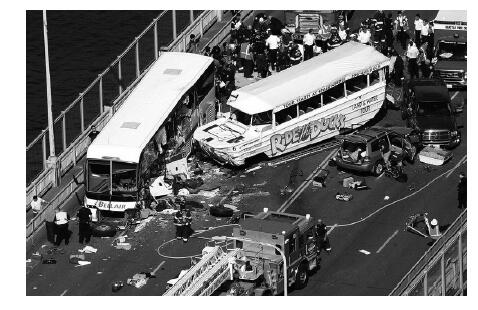Chapter 16
| Jurisdiction | United States |
"I hear and I forget. I see and I remember. I do and I understand."
Confucius
A. Experiential Learning
This chapter offers you the opportunity to work with litigation visuals and today's technology. By completing these assignments, you can learn how to make presentations in both pretrial alternative dispute resolution settings and trial. Your instructor may select as many of the assignments as are appropriate for your situation. For instance, many of the assignments may be utilized in a pretrial or trial advocacy course that allots a significant number of class sessions to visual litigation. Or, selected assignments may serve as the curriculum for a continuing legal education seminar or a law school course dedicated exclusively to litigation visuals and technology.
B. Case Synopses and Case Files
This chapter provides you with synopses of Dinh v. Ride The Ducks Int'l, which is an actual civil case, and State v. Carroll, which is a modified hypothetical case of felony assault in the first degree. Your instructor can select one or both cases to serve as the fact patterns for you to use in performing the assignments.
Participants are provided with case files for both the civil Dinh v. Ride The Ducks Int'l case and the criminal State v. Russell Carroll case. The civil and criminal case files are posted on http://www.fastcase.com/visuallitigation. The case files contain all the information needed for the assignments, including witness statements, photographs, jury instructions, a complaint and answer for the civil case, and information for the criminal case.
C. Teacher's Manual, Actors' Guide, CLE Schedule of Instruction, and Syllabus
Your instructor's teacher's manual contains teaching notes. It also includes supplementary materials for the course, such as a schedule of instruction for a continuing legal education seminar, and a syllabus for law school classes. Your instructor also receives a guide that provides other court documents as well as role-playing instructions for witnesses. Your instructor may have you rely on either the law stated in Chapter 8, "Evidentiary Predicates," or your state's law.
D. Case Synopses
1. Civil Case Synopsis

Dinh v. Ride The Ducks International
Ride The Ducks of Seattle (RTDS) is a tourist attraction. Tourists climb aboard an amphibian landing craft developed during World War II. The tour starts at Seattle's waterfront and moves to Lake Union where it enters the water and travels around the lake before returning to the road and heading downtown. Along the route, the captain (driver) entertains the passengers with banter and a description of the city's sites.
On September 24, 2015, one of the amphibians, Duck #6 from the RTDS fleet was filled with tourists when it started across the Aurora bridge. While crossing the bridge its front axle failed, and the Duck drifted into the oncoming lane. It collided with a charter bus carrying international students from North Seattle College.
Upon impact, passengers in Duck #6 flew out the open windows of the vehicle. Students on the bus were tossed around. The crash resulted in five international students dying and sixty people injured.
Forty plaintiffs sued Ride The Ducks International (RTDI), which is based in Branson, Missouri, and RTDS (a licensee of RTDI) for negligence in manufacturing and maintaining Duck #6. The plaintiffs also sued the City of Seattle and the State of Washington for negligently failing to erect a barrier between the north and south lanes on the Aurora bridge on the theory that head-on collisions had occurred in the past on the bridge and that a barrier would have prevented Duck #6 from colliding with the bus.
In 2003 and 2004, before the Ride The Ducks business was sold to new owners of RTDI, fractures were found in the axle housings of the Ducks. Without consulting with an engineer or mechanic, the then-owner cobbled together a solution to the problem with material scavenged from a junk yard. On July 2013, more than two years prior to the Ride The Ducks disaster on the Aurora bridge, the left wheel fell off a Duck that was being driven in Branson, Missouri. Shortly after that, another Duck, which was being driven in Branson, had an axle defect that caused the wheels to cant. RTDI did not employ an engineer to fix the axle problem. Rather, RTDI did its own repairs.
Although RTDI was a manufacturer of the Ducks, it did not register as a manufacturer. Manufacturers, under federal regulations, are required to report vehicle defects, but RTDI did not report that the axles were failing.
RTDI did do something: it issued a service bulletin with a diagram showing how to fix the axle. The bulletin stated that the fix should be done "as soon as practical" and before 2014. RTDI would repair defects for its franchisees but was not required to do so for licensees. Because RTDS was a licensee, RTDI merely sent RTDS a service bulletin. RTDS did not make the fix the bulletin recommended. RTDS asserts that it was inundated with RTDI service bulletins, some of which were trivial.
On September 20, 2015, four days before the Ride The Ducks disaster on the bridge, the driver of Duck #6 pulled the Duck over while crossing the Aurora bridge because she felt something unusual and heard an unusual sound. The driver contacted the mechanics and told them something was wrong. The mechanics, who were overworked and understaffed, did not remove the rubber boot that covered the axle. The mechanics had not been provided with the service bulletin.
Simon Lee was driving behind Duck #6 as it crossed the Aurora bridge. He saw the wheel on the Duck give way and the vehicle go out of control, leaning to the left and careening into the...
To continue reading
Request your trial
